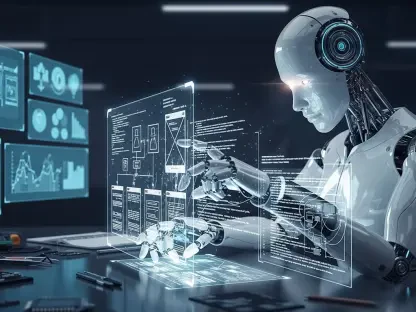Imagine a world where writing software is as simple as describing an idea in plain English, and within moments, a fully functional application emerges, crafted by an unseen digital assistant. This scenario, once the stuff of science fiction, is becoming a reality with artificial intelligence (AI) reshaping the landscape of software development at an unprecedented pace. Recent surveys indicate that over 60% of developers now use AI-powered tools to assist in coding tasks, marking a seismic shift in how technology is built. Much like the introduction of high-level programming languages revolutionized coding in the mid-20th century, AI stands poised to redefine the craft, making it more accessible yet sparking debates about its ultimate impact. This analysis delves into AI’s meteoric rise in programming, explores its current applications, gathers expert insights, and peers into its future implications, culminating in key takeaways for navigating this transformative trend.
The Rise of AI in Software Development
Growth and Adoption Trends
The integration of AI into software development has surged dramatically in recent years, with adoption rates reflecting a profound industry shift. According to data from GitHub, millions of developers now rely on AI coding assistants like Copilot, with usage stats showing a consistent upward trajectory since their widespread introduction. This rapid embrace underscores how AI tools have become integral to modern workflows, particularly in streamlining repetitive tasks.
Beyond raw numbers, the growth of generative AI and large language models (LLMs) has fueled an exponential increase in their application across development environments. Industry reports highlight that enterprises and startups alike are embedding these technologies to enhance efficiency, with many noting significant reductions in time spent on routine coding. This trend points to a broader acceptance of AI as a core component of the developer toolkit, reshaping traditional practices.
A notable pattern is the increasing dependence on AI for complex tasks such as code generation and debugging. From small tech firms to global corporations, organizations report a growing reliance on these tools to maintain competitive edges in fast-paced markets. This pervasive adoption signals a fundamental change, positioning AI not merely as an accessory but as a cornerstone of contemporary software creation.
Real-World Applications and Case Studies
AI’s practical impact shines through in specific tools that have become household names among developers. GitHub Copilot, powered by OpenAI’s Codex, exemplifies this by offering real-time code suggestions, often slashing development time for routine functions. Developers using such tools frequently report productivity boosts, with some projects completed in half the expected duration.
Case studies further illuminate AI’s transformative potential, as seen in major tech companies integrating these solutions into their pipelines. For instance, a leading software firm documented a 30% reduction in prototyping cycles after adopting AI-driven assistants, enabling faster iterations and market delivery. Such outcomes highlight how AI empowers teams to focus on innovation rather than repetitive coding chores.
Additionally, AI extends beyond code creation to applications like automated code reviews and bug detection, proving invaluable across industries from finance to gaming. Natural language-to-code translation also emerges as a game-changer, allowing non-technical stakeholders to contribute to development by simply describing desired features. These diverse uses underscore AI’s versatility, cementing its role as a multifaceted asset in modern programming.
Expert Perspectives on AI’s Role in Coding
Industry leaders and analysts offer a spectrum of views on AI’s burgeoning influence in programming, balancing optimism with caution. Many developers praise AI for democratizing access to coding, noting how it enables novices to build functional applications without deep technical knowledge. This accessibility is seen as a significant step toward broadening the tech talent pool.
However, challenges such as comprehension debt—where users adopt AI-generated code without fully understanding it—draw concern from experts. Analysts warn that over-reliance on AI risks creating fragile systems, especially when errors go unnoticed by less experienced users. This tension between convenience and competence fuels ongoing discussions about AI’s appropriate role in development.
Contrasting opinions also surface on whether AI could ever supplant human developers. While some envision a future of near-total automation, others argue that the human capacity for critical thinking and problem-solving remains irreplaceable. These varied perspectives emphasize AI’s current status as a powerful assistant, enhancing rather than replacing the nuanced expertise of seasoned programmers.
Future Implications of AI as a Programming Tool
Looking ahead, AI’s trajectory in software development promises even greater advancements, particularly in natural language processing. Enhanced models could soon interpret complex user requests with higher precision, generating sophisticated code with minimal input. Such progress hints at a future where barriers to entry in programming diminish further.
Potential benefits include a wider democratization of coding, empowering individuals with little to no technical background to create software. Yet, this also raises challenges, as the need for oversight by skilled developers becomes more critical to address AI errors or limitations. Balancing automation with human expertise will likely shape the evolution of development practices.
Broader implications span industries, with an anticipated rise in demand for engineers adept at refining AI outputs. Ethical concerns also loom, as automation sparks debates about job displacement and the societal impact of reduced human involvement in tech creation. Navigating these dynamics will require thoughtful strategies to ensure AI serves as a complement to human ingenuity rather than a competitor.
AI’s Place in the Programming Landscape
Reflecting on the journey, AI’s ascent in software development marks a pivotal era, with its growth, tangible impacts, and expert debates painting a vivid picture of transformation. The technology has proven itself a formidable ally, enhancing productivity through real-world applications while revealing limitations that demand human oversight. Experts weigh in with balanced views, acknowledging AI’s potential to broaden access to coding yet cautioning against over-dependence. Looking back, the consensus holds that AI thrives as an assistant, not a replacement, for the irreplaceable depth of human expertise. Moving forward, stakeholders are encouraged to harness AI tools with a discerning eye, integrating them into workflows while investing in skills to manage their outputs. Embracing this synergy promises to unlock innovation, ensuring that technology and human creativity advance hand in hand.









